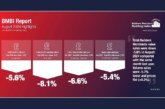
Construction output is forecast to increase 5.3% in 2015 and 17.8% by 2018 according to the latest forecasts from the Construction Products Association, but growth is expected to slow in the medium-term due to election uncertainty and capacity constraints. Beyond this, many commentators also point to an underlying skills shortage which — if not acted upon now — will have a significant long term effect.
Key highlights from the CPA data predict that private house building is forecast to rise 10.0% in 2015 and 20.2% by 2018 whilst commercial offices construction is expected to increase 8.0% this year and 25.0% by 2018. Infrastructure activity, meanwhile, is forecast to rise 7.9% in 2015 and 51.5% by 2018.
CPA Economics Director Dr Noble Francis commented: “Whilst output in the sector during 2014 was 8.5% below the level seen in 2007, overall capacity last year was not a key issue. However, construction output is forecast to surpass the pre-recession peak during the next 18 months, this despite the industry having lost 343,000 jobs and considerable materials capacity in the seven years following the financial crisis. As a result, it is essential that there is significant investment in UK construction skills and manufacturing over the next few years if the growth forecast is to be achieved.”
The Federation of Master Builders, meanwhile, warns that a “construction skills time bomb is ticking”. Citing the results of its latest State of Trade Survey, the FMB states that skills shortages are on the increase across a number of trades and professions with many small construction firms experiencing particular difficulties recruiting carpenters, joiners and bricklayers.
Its Chef Executive Brian Berry said: “This time last year, for example, only 27% of firms were struggling to recruit bricklayers — that figure now stands at a sizeable 42%. The FMB is working hard to help address this skills shortage but the Government must also play its part. If Ministers could do one thing to help address the problem in the medium term, it should be to review its proposed apprenticeship funding reforms, which our members tell us will prevent them from being able to train apprentices. In the midst of a skills crisis, it’s the last thing the construction industry needs.”
The warning is echoed by research from the Royal Institution of Chartered Surveyors (RICS) which suggests that by 2019 worsening skills shortages will threaten 27,000 building projects a year. 85% of surveyors questioned said that a lack of qualified candidates meant they had problems recruiting with around two in five (43%) firms already turning down new business due to a dearth of skilled workers — with each of them passing up an average of five contracts per year.
Alan Muse, Director of Built Environment Professional Groups at RICS, said: “Surveyors play a pivotal role in the delivery of every construction project. Simply put, without surveyors, things don’t get built. The next few years look like a real tipping point — construction as an industry looks set to grow, but at this rate it’s very unlikely that we’ll have the capacity or the capability to fulfil planned.
Inclusive kitchen and bathroom sector to grow by 20% to 2018
With an ageing population, an increase in the number of people with disabilities and a trend towards multi-generation households, AMA Research is predicting significant growth for inclusively designed bathrooms and kitchens. In 2014, the sector was estimated to be worth around £150 million at Manufacturers Selling Prices (MSP) and since 2013, it has seen a notable increase.
“The number of people aged 65 and over has increased by 17.3% since 2003 and the fastest growing household type in 2013 was households containing two or more families,” said AMA’s Keith Taylor. “The shortage of affordable housing and the increase in elderly relatives in need of care are driving more families to house three generations in one property and this could lead to specialist kitchen and bathroom equipment being installed in a wider range of properties.”
The market has been positively impacted the trend towards product solutions that are suitable for all users, with products becoming much more aesthetically pleasing combing functionality and style. Furthermore, with revisions to Part M of the Building Regulations and the Lifetime Homes Standard, inclusive products have been progressively installed in a wider range of end-use applications including domestic homes and commercial environments such as hospitals and schools.
AMA’s ‘Inclusive Bathroom and Kitchen Products Market Report –UK 2014-2018 Analysis’ estimates the sector will be worth in excess of £180 million by 2018 — an increase of around 20% when compared to 2014.









